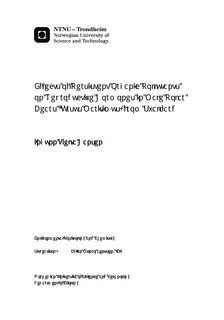| dc.description.abstract | PCBs and other environmental contaminants have been found to have an effect on steroid hormones in polar bears (Ursus maritimus). The purpose of this study was to investigate the effect of persistent organic pollutants (POPs) on the steroidogenesis in male polar bears from Svalbard. Blood samples from male polar bears (n=23) were collected at Svalbard, Norway in April 2008 as a part of the International Polar Year-project, BearHealth. The sampled individuals were between 3-21 years, where individuals under 5 years (n=6) were categorized as subadults. Serum and plasma samples were analysed for steroid hormones (pregnenolone (Pre), progesterone (Pro), androstenedione (AN), dehydroepiandrosterone (DEA), testosterone (TS), dihydrotestosterone (DHT), estrone (E1), estradiol-17α (E2-α) and estradiol-17β (E2-β)) with a recently developed gas chromatography-tandem mass spectrometry (GC-MS/MS) determination method, whereas cholesterol concentrations were measured by Reflotron. The environmental contaminants (HCB, α‐HCH, β‐HCH, oxychlordane, trans‐nonachlor, mirex, p,p'-DDE, p,p'‐DDT, PCB‐47, PCB‐74, PCB‐99, PCB‐101, PCB‐128, PCB‐137, PCB-138, PCB‐153, PCB‐170, PCB‐180, PCB‐183, PCB‐187, PCB‐194, PCB‐206, PCB-105, PCB-114, PCB-118, PCB-156, PCB-157, PCB-167, PCB-189, 4'-OH-CB107, 4'-OH-CB130, 3'-OH - CB138, 4‐OH‐CB146, 4'-OH‐CB159, 4'-OH-CB172, 3'-OH-CB180, 4-OH‐CB187, BDE-47, BDE-154) included in this study were analysed by gas chromatography-electron capture detection (GC-ECD) or GC/MS. Multivariate regression analysis, principal component analysis (PCA) and orthogonal partial least squares (OPLS) regression, were performed to investigate the influence of the contaminants on the steroid hormones in the adult individuals. Only the OPLS model with DHT as the response variable was significant. Most of the environmental contaminants had a significantly negative contribution on the variation in dihydrotestosterone concentrations. Based on the statistical analyses, the poly-ortho PCBs and HCB might be more central in explaining the variation in DHT concentrations, while PBDEs and OH-PCBs seems to be less important. Androstenedione were found to be the androgen with highest concentration in circulating blood from male polar bears, unlike other studies on mammals where testosterone has been found to be the most abundant androgen. The high level of AN might be connected to the negative effect of contaminants on DEA levels. The GC-MS/MS method applied in the current study can successfully compete with other frequently used determinations methods, such as RIA. The method is appropriate for the study several steroid hormones and their precursors in male polar bears and can be recommended for studies investigating the effect of persistent organic pollutants on the on the steroidogenesis. | nb_NO |

